It’s a rainy October afternoon in Dobbiaco, South Tyrol Italy, home of the International Commission for Alpine Rescue Congress. The venue, right in the heart of the Dolomites, is the perfect theater to host the annual International Mountain Rescue event. The tall walls of the Cultural Center Gustav Mahler witnesses the constant flow of rescuers from all over the world, with their bright colored jackets, flooding the scene with camaraderie and the joy of finding old and new friendships.
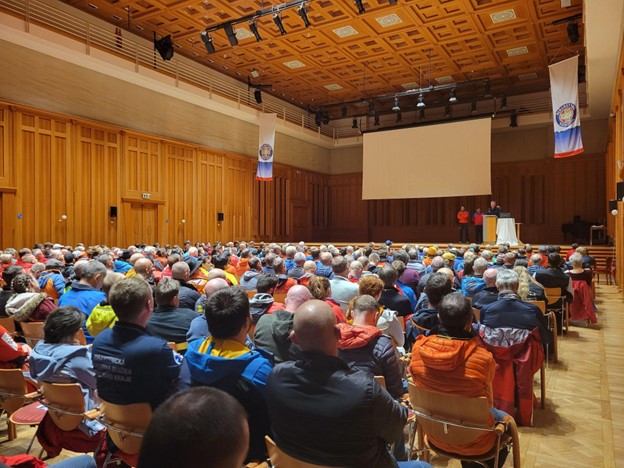
ICAR Congress inauguration in Dobbiaco, South Tyrol. Photo credit: Martin Musi
Our host, mountain rescue service in the South Tyrol Alpine Association, has worked hard over the last year to welcome teams from all over the world. South Tyrol was also the center of the mountain rescue scene 69 years ago. Since then, ICAR has provided a platform for mountain rescue and related organizations to disseminate knowledge with the goal of improving the safety and effectiveness of mountain rescue services worldwide. ICAR currently has 123 member organizations in 41 countries with the Wilderness Medical Society now a proud member.
The first day of the conference was at the stunning mountain setting of the three peaks from Cime di Lavaredo. Here, every commission of ICAR presents relevant topics to the members of the commission with an emphasis on hands-on practical skills. The Alpine Emergency Medicine Commission (MEDCOM) presented a variety of topics including the management of multiple injured patients in the mountains, drowning, improvised rescue, accidental hypothermic cardiac arrest, splinting, advanced airway techniques, minimally invasive procedures for the management of trauma patients in the field, and suspension syndrome, among others. The Air Rescue Commission (AIRCOM) presented important work related to the coordination and deconfliction of drones and helicopters, the Avalanche Rescue Commission (AVACOM) presented a practical demonstration on electronic interference in avalanche transceivers, the Terrestrial Rescue Commission (TERCOM) demonstrated anchor placements including glue in bolts and other novel technologies and the Sub-Commission of Dog-Handlers (DOGCOM) presented topics related to use of GPS for rescue dogs and training of rescue pups.
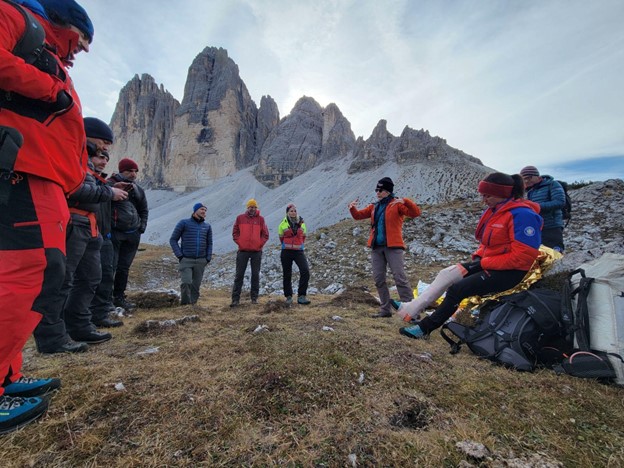
Dr. Alison Sheets teaching the foundational skill of splinting to a group of rescuers with the Tre Cime de Lavaredo in the background. Photo credit: Martin Musi
The day finished with an impressive demonstration of a 90-meter long-line helicopter mid-wall pick-off of stranded climbers off the spectacular Tre Cime.
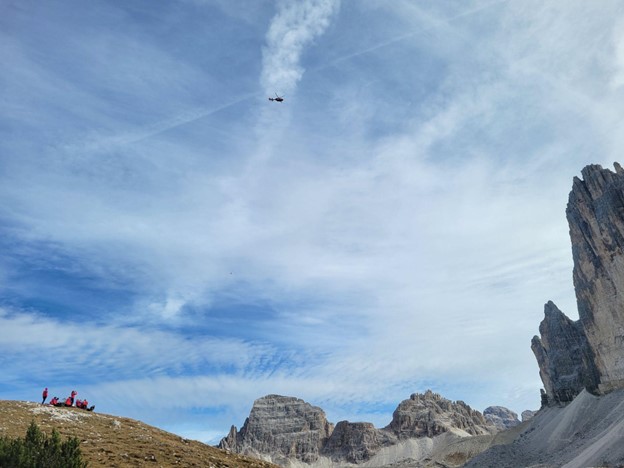
Helicopter pick-off demonstration by the local SAR team. Photo credit: Martin Musi
The next three days of the congress provided an interesting variety of commission recommendations, discussions, research results, and case reports. A central topic during the Congress was the importance of psychological first aid for rescuers. “Recommendations for Stress Resilience in Alpine Rescue” was presented to the MEDCOM by a working group led by Dr. Alison Sheets. The 12 recommendations were separated into three categories: preparation, during exposure, and after exposure to a traumatic or stressful event. It also included important tools like the Mountain Rescue Stress Continuum , the 3:3:3 (days/weeks/months) incident follow-up strategy, and the Traumatic Stress Questionnaire. The ICAR MEDCOM approved the recommendations and presented them to the general assembly of delegates for a final vote of approval, a typical process for every ICAR recommendation.
Other presented research included titles like “Prospective Study of Avalanche Deaths - a Complete Overview of the Rescue Chain” a large research effort that looked at an existing avalanche death registry in the French Alps with the intent to gather information to improve data collection and field management of avalanche victims.
I presented an update on Mountain Medicine in Latin America and the development of DiMM+Andes and DiMM Chile in the region. Our program offers scholarships to all Latin American participants with the help of sponsors and participants from outside Latin America.
On day two, we learned about a variety of rescue topics from all over the world. For example, Dr. Mario Milani, a rescue doctor from Italy, presented his research in Occupational Accidents Among Search and Rescue Providers during Mountain Rescue Operations and Training Events, a review of Italy’s statistics for accidents that occur to rescuers in the line of duty. Accidents during training were responsible for 59% of the incidents, with falls as the most common reason for rescuer injury.
ICAR is not strictly an “educational meeting”. It is a platform to meet fellow rescuers and engage in active participation towards the advancement of knowledge in mountain search and rescue. You don't get lectured in ICAR; you are asked to give your opinion from a rescuer perspective on topics that affect your institution's operations. As an example, Dr. Kyle McLaughlin, from Parks Canada, sought input from the entire ICAR community on a massive scoping review “Rescue at Very High Altitude”; including PICO questions– Research question that inquiries about the Population, the Intervention, the Control and the Outcomes-such as do rescuers need pharmacologic prophylaxis when responding to very high altitude, what medications are necessary or effective, what is optimal duration for prophylaxis treatment, helicopter use, crew , and emergency procedures, to name a few. This is a massive work that has involved members of each commission at ICAR, a strong community of hard-working individuals representing organizations from around the world.
Dr. Giacomo Strapazzon and Dr. Simon Rauch from EURAC Research presented an analysis of a multi-casualty incident in The Marmolada Glacier Collapse, illustrating possible implications of climate change. The accident occurred on July 3, 2022 as many climbers were descending the regular route from the summit of Punta Penia. There were 11 fatalities and 7 severely injured subjects. The avalanche was calculated to contain 70,000 cubic meters of ice, rock, and water. The disaster was at the junction of three different regional authorities, so the coordination of air assets, patient identification, and transport destinations was difficult. Multi-agency communication was complicated by a lack of pre-planned common radio channels, and rescuers who spoke different languages. After survivors were evacuated, the decision was made to get personnel and equipment off the scene and use UAVs–Un-piloted Aerial Vehicle- to continue search efforts as further ice fall was a concern. The discussion concluded with lessons learned from the incident, including the considerations for rescuer safety, the necessity to strengthen the local communication systems before incidents, and the importance of interagency training opportunities to improve coordination of response, patient care, and evacuation.
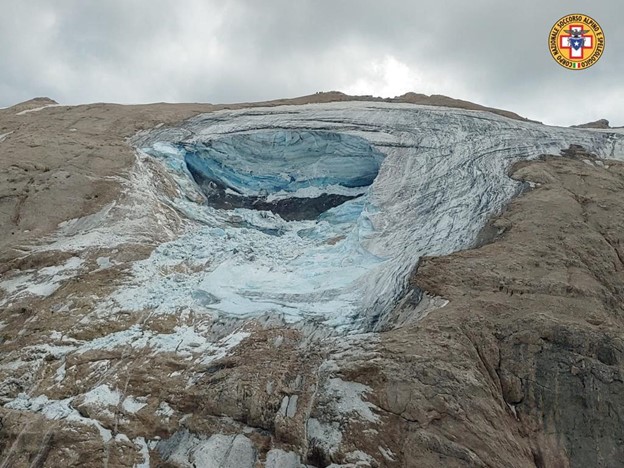
The Marmolada Glacier with a massive missing portion, the collapse of the glacier generated a Multiple Casualty Incident. Source: Reuters
On the last event of the Congress, the Assembly of Delegates kicked off with a solemn minute of silence for all the rescuers around the world who have died in or out of the line of duty. We celebrated the recently recognized “ICAR - International Mountain Rescue Day” - commemorating a pivotal gathering on August 28th, 1948, that led to the founding of ICAR, hopefully, a date that will soon be recognized by the United Nations. Finally, The Wilderness Medical Society was voted by 256 delegates to advance its membership status to an organization with voting rights. This is a huge step for WMS to take part in the major rescue organization in the world and contribute with our medical expertise to the field of Mountain Search and Rescue.
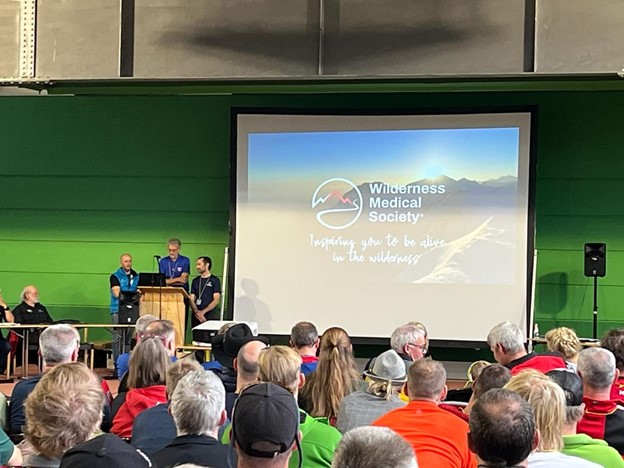
The Wilderness Medical Society advances its membership status at the ICAR Assembly of Delegates. Photo Credit: Manuel Funk, MD